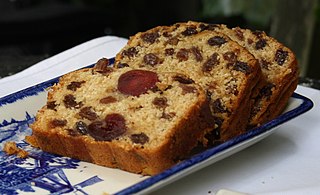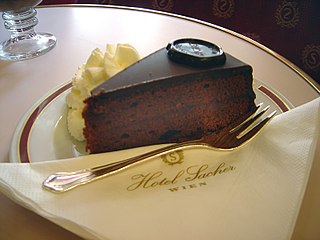
Dessert is a course that concludes a meal. The course consists of sweet foods, such as confections, and possibly a beverage such as dessert wine and liqueur. In some parts of the world, such as much of Greece and West Africa, and most parts of China, there is no tradition of a dessert course to conclude a meal.

Cake is a flour confection made from flour, sugar, and other ingredients, and is usually baked. In their oldest forms, cakes were modifications of bread, but cakes now cover a wide range of preparations that can be simple or elaborate, and which share features with desserts such as pastries, meringues, custards, and pies.

Trifle is a layered dessert of English origin. The usual ingredients are a thin layer of sponge fingers or sponge cake soaked in sherry or another fortified wine, a fruit element, custard and whipped cream layered in that order in a glass dish. The contents of a trifle are highly variable and many varieties exist, some forgoing fruit entirely and instead using other ingredients, such as chocolate, coffee or vanilla. The fruit and sponge layers may be suspended in fruit-flavoured jelly, and these ingredients are usually arranged to produce three or four layers. The assembled dessert can be topped with whipped cream or, more traditionally, syllabub.

Hungarian or Magyar cuisine is the cuisine characteristic of the nation of Hungary and its primary ethnic group, the Magyars. Traditional Hungarian dishes are primarily based on meats, seasonal vegetables, fruits, bread, and dairy products.

Austrian cuisine is a style of cuisine native to Austria and composed of influences from Central Europe and throughout the former Austro-Hungarian Empire. Austrian cuisine is most often associated with Viennese cuisine, but there are significant regional variations.

Fruitcake is a cake made with candied or dried fruit, nuts, and spices, and optionally soaked in spirits. In the United Kingdom, certain rich versions may be iced and decorated.

Sachertorte is a chocolate cake, or torte of Austrian origin, invented by Franz Sacher, supposedly in 1832 for Prince Metternich in Vienna. It is one of the most famous Viennese culinary specialties.

Black Forest gâteau or Black Forest cake is a chocolate sponge cake with a rich cherry filling based on the German dessert Schwarzwälder Kirschtorte, literally "Black Forest Cherry-torte".

A Swiss roll, jelly roll, roll cake, cream roll, roulade or Swiss log is a type of rolled sponge cake filled with whipped cream, jam, or icing. The origins of the term are unclear; in spite of the name "Swiss roll", the cake is believed to have originated elsewhere in Central Europe, possibly Austria or Slovenia. It appears to have been invented in the nineteenth century, along with Battenberg cake, doughnuts, and Victoria sponge. In the U.S., commercial versions of the cake are sold with the brand names of Ho Hos, Yodels, Swiss Cake Rolls, and others. A type of roll cake called Yule log is traditionally served at Christmas.

Christmas cake is a type of cake, often fruitcake, served at Christmas time in many countries.

The frog cake is an Australian dessert in the shape of a frog's head, composed of sponge cake and cream covered with fondant. It was created by the Balfours bakery circa 1923, and soon became a popular treat in South Australia. Originally frog cakes were available exclusively in green, but later brown and pink were added to the range. Since then other variations have been developed, including seasonal varieties. The frog cake has been called "uniquely South Australian", and has been employed in promoting the state. In recognition of its cultural significance, in 2001 the frog cake was listed as a South Australian Heritage Icon by the National Trust of South Australia.

Rainbow cookie or rainbow cake usually refers to a three-layered almond-flavored Italian-American cookie, but can also refer to any of a number of rainbow-colored confections.

Rigó Jancsi is a traditional Hungarian cube-shaped chocolate sponge cake and chocolate cream pastry. It gained popularity in the former Austria-Hungary and is named after Rigó Jancsi (1858–1927), a famous Hungarian Gypsy violinist.

Opera cake is a French cake. It is made with layers of almond sponge cake soaked in coffee syrup, layered with ganache and coffee French buttercream, and covered in a chocolate glaze. Its namesake originates from the layers resembling the levels of an opera house.

Sponge cake is a light cake made with egg whites, flour and sugar, sometimes leavened with baking powder. Sponge cakes, leavened with beaten eggs, originated during the Renaissance, possibly in Spain. The sponge cake is thought to be one of the first of the non-yeasted cakes, and the earliest attested sponge cake recipe in English is found in a book by the English poet Gervase Markham, The English Huswife, Containing the Inward and Outward Virtues Which Ought to Be in a Complete Woman (1615). Still, the cake was much more like a cracker: thin and crispy. Sponge cakes became the cake recognized today when bakers started using beaten eggs as a rising agent in the mid-18th century. The Victorian creation of baking powder by English food manufacturer Alfred Bird in 1843 allowed the addition of butter to the traditional sponge recipe, resulting in the creation of the Victoria sponge. And today our celebrations are incomplete without cakes. Cakes are available in millions of flavours and have many recipes as well. Sponge cakes have become snack cakes via the Twinkie.
The second season of Top Chef: Just Desserts was broadcast on Bravo. It featured 14 pastry chefs fighting to win the title of Top Chef.
Cookie butter is a food paste made primarily from speculoos cookie crumbs, fat, flour, and sugar. The ingredients are mixed until it becomes spreadable on a sandwich. In countries like Belgium, the Netherlands, and France, it is a common alternative to nut butter and chocolate spreads.















